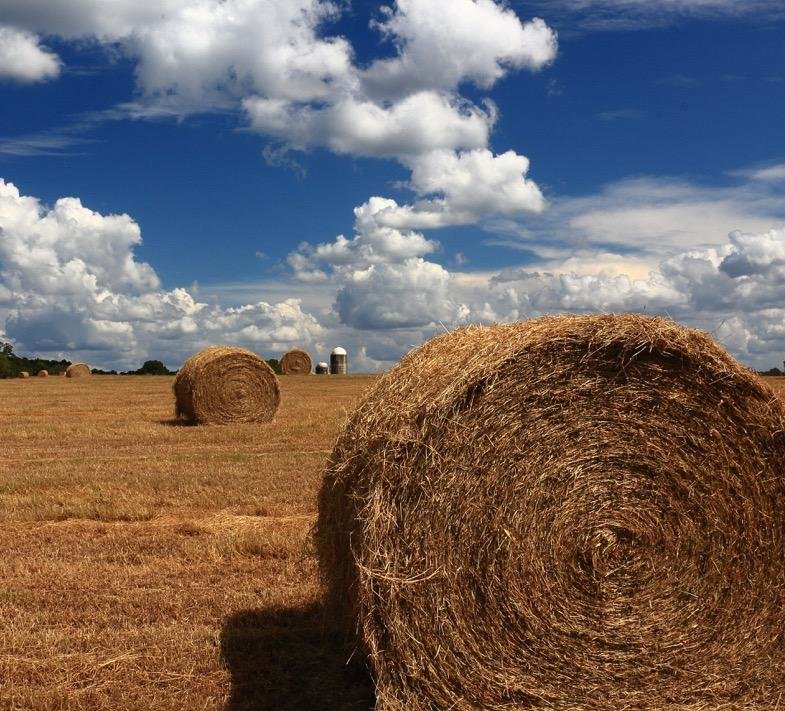Making hay while the sun shines
tompol@earthlink.net
Something about hay bales makes me feel good.
Maybe it’s because man and nature assure cattle and horses future meals.
Maybe it’s because I stop and smell the hay.
Folks urge each …
This item is available in full to subscribers.
Subscribe to continue reading. Already a subscriber? Sign in
Get 50% of all subscriptions for a limited time. Subscribe today.
Please log in to continueNeed an account?
|
Making hay while the sun shines
tompol@earthlink.net
Something about hay bales makes me feel good.
Maybe it’s because man and nature assure cattle and horses future meals.
Maybe it’s because I stop and smell the hay.
Folks urge each other to stop and smell the roses. I say take time to smell the hay, a fragrance reminiscent of bread baking in an oven.
Make a summer’s day drive into the country and you’ll spot them. Fresh-cut bales scatter across fields along back roads as if a giant casually tossed them about.
Down dusty roads, I enter the province of old gas pumps and fields rife with big round bales. I’ve seen plastic-wrapped round bales lined against an edge of forest. From afar they resemble a big albino caterpillar.
My favorite scenes are like the one you see here. You’re in farm country, far from the city and its noise and congestion.
But how does hay happen? Just let the stuff grow and then cut it? No.
Hard work and patience – that’s what’s behind all those bales, for hay is not a cut-and-dried subject.
A farmer needs 3 days to make hay while the sun shines, an old saying that sure tells the truth, for rain and mold ruin hay.
Fortunately, we get a lot of sunshine down South.
Imagine golden sunshine raining down on a deep green field of Coastal Bermuda. As it heats up and dries, a heavenly scent rises.
When I stopped to take the photograph above, swirls of air greeted me, eddies rich with the fragrance of life.
It takes farm equipment to move the big bales around. Not square bales. How well I recall how hot, sweaty, and itchy it was “getting up” square bales.
The coldest Coca Cola I ever drank was while gathering hay on a blazing hot summer day at my grandfather’s farm.
Aunt Vivian went to a country store and returned with a cooler of Coca Colas from an ice-filled vat. Sitting beneath a persimmon tree, a breeze in my face, I downed it in seconds.
Square bales? (Truth be told they’re rectangular.) I just don’t see them, but it’s common to see round bales wrapped in plastic. Why is that?
“Essentially, the farmers are making silage out of hay,” said Dr. Matthew Burns, the Extension Beef Specialist, Livestock and Forage Program Team Leader at Clemson.
“The old way – and people still do that with corn and sorghum – is to chop it and put it in a pit or bag and make silage of it.” Burns said more people have started doing baleage as it provides leeway on not having to get the crop all the way dried down because you want some moisture.
“You don’t do it with every crop,” he said, adding that if the process goes as it should you don’t have to worry about mold.
Down in the sunny South we make hay when the rest of the country can’t. Consider hay as insurance against a stretch of bad weather.
Remember when drought struck farmers in Texas? Farming families grow insurance, provided Mother Nature gives them 3 good days of weather at a favorable time.
Old Sol usually does his job, and man and beast alike get to enjoy hay, what the old folks called fodder.
Parts of this column first appeared in South Carolina Farmer magazine.
Keywords
down south, making hay, hay bales, hay, tom polandOther items that may interest you







Comments
No comments on this item Please log in to comment by clicking here